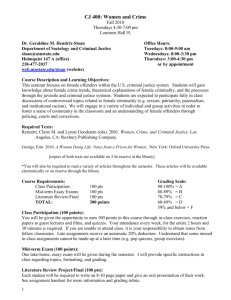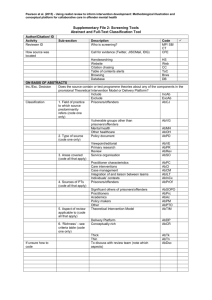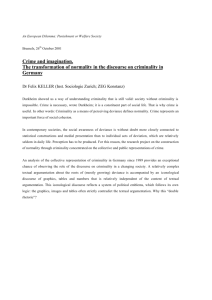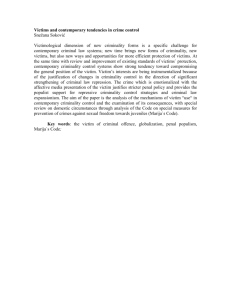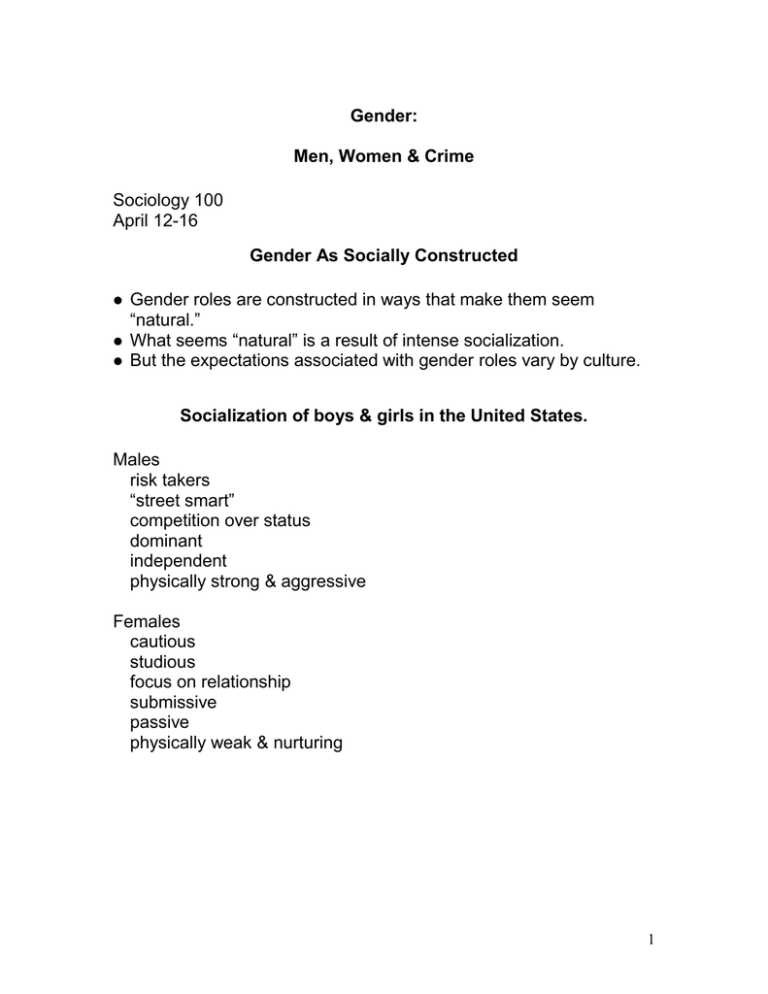
Gender:
Men, Women & Crime
Sociology 100
April 12-16
Gender As Socially Constructed
Gender roles are constructed in ways that make them seem
“natural.”
What seems “natural” is a result of intense socialization.
But the expectations associated with gender roles vary by culture.
Socialization of boys & girls in the United States.
Males
risk takers
“street smart”
competition over status
dominant
independent
physically strong & aggressive
Females
cautious
studious
focus on relationship
submissive
passive
physically weak & nurturing
1
Male gender as a predictor of criminality . . .
93% of the prison population is male.
Males implicated in more violent crimes than women
Masculine socialization is the key to higher rates of criminality &
types of criminality.
Influence of class: Middle-class males can take advantage of the
power structure to achieve & demonstrate masculinity.
Other males (poor, minority) may look for different routes to prove
their masculinity and power.
Boys, Girls & Delinquency
Top 5 Offenses in 1994
(as a % of total Arrests)
Boys’ Arrests (1994)
larceny theft 17.2
other offenses 16.4
other assaults 7.7
drug abuse
7.1
vandalism
6.7
All serious violent offenses
Girls’ Arrests (1994)
larceny theft
25.6
runaway
17.1
other offenses 14.4
other assaults
8.6
disorderly con- 6.0
duct
All serious violent offenses
6.6
3.4
2
Women & Crime
Women who violate laws also violate the norms for their gender.
They are “doubly deviant”
Women’s criminality has different origins compared to men’s
criminality
Women tend to be involved in some types of crimes more than
others
Female minors more likely to be arrested for status offenses
compared to boys
Female criminals have a lower status compared to male criminals
(more likely to be lower on the “food chain” compared to males).
Increases in Female Criminality?
See handout
Increases in Female Prisoners – National vs. Hawaii
National Increases in Female Prisoners versus Hawaii
Nationally, the average annual percentage increase for women
prisoners between 1980 and 1998 was 8.5%
For Hawaii, the average annual percentage increase for women
prisoners between 1980 and 1998 was 12.2%
Females in Hawaii are now 12% (2003) of the incarcerated
population.
3
Are Women Becoming More Criminal?
Between 1990 to 1997, drug offenders accounted for the largest
source of total growth among female inmates.
Number of male drug offenders grew by 48%
Number of female drug offenders grew by 100%
The increases seen among male & female violent offenders grew
by 64% & 68%
Are female offenders liberated?
The “pathways” to prison for women vary from those of men.
Female inmates more likely to report sexual or other abuse,
experience addiction, have poorer education compared to male
counterparts.
Female survival strategies are likely to be “criminalized” – running
away; prostitution; welfare fraud.
Female Offenders . . .
Women are likely to medicate themselves with street drugs for
depression and PTSD.
Women inhabit the lower positions in drug trafficking networks;
more likely to get caught
Less likely to be able to provide prosecution with “substantial
assistance” in return for reduced sentencing.
For men, relationships often mean turning away from crime – for
women, relationships may provide an introduction to violence and
crime.
4
Female vs. Male Admissions (New) to Prisons in 1996
Increases in women’s arrest & incarceration reflect:
Changes in law enforcement practices
Feminization of poverty
Changes in categorizing crimes/data collection
Very small initial or base numbers
War on Drugs
5


